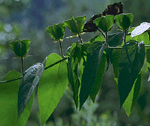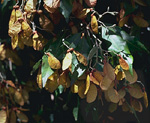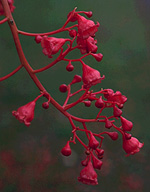 |
This family is widely distributed in the tropics and Southern Hemisphere subtropics in both the New and Old Worlds. In Australia it is found almost anywhere except treeless plains and in the alps, from rainforests and monsoon forests to sclerophyll forests and heathlands.
Characteristic features of the family Sterculiaceae in Australia include: - trees or shrubs, usually rather soft-wooded and often with coarse, often rusty, stellate hairs on young branches and leaves
- leaves alternate, simple to palmately compound or lobed, often rather dark green or greyish
- flowers usually rather dully-coloured, red, blue, pink or white, regular, with 5 sepals and 5 often rather thick-textured petals, both whorls united into often bell-shaped or funnel-shaped tubes or more or less free, or the petals absent and the sepals coloured instead
- stamens few to numerous, sometimes more or less joined into a tube, usually dark-coloured and often with some sterile and modified into gland-like staminodes
- ovary superior, of free or united carpels, developing into a capsule, a follicle splitting down one side, a dry, winged nut, or rarely the fruit fragmenting at maturity
Description
Evergreen, deciduous or semi-deciduous trees or shrubs, rarely
annual, biennial or perennial terrestrial herbs. Perennating by rhizomes
or taproots. Vegetative reproduction absent, or by rhizomes. Extra-floral
nectaries absent, or on the stems. Stem internodes solid, or spongy, or
pithy. Internal secretions not obvious, or of resin. Plants with simple,
dendritic, stellate, clavate, capitate or vesicular glandular or non-glandular,
unicellular, uniseriate or multiseriate hairs, or peltate scales. Leaves
well developed or rarely much reduced, alternate and spiral, or distichous,
or opposite, or apparently whorled, cauline if herbs, petiolate or subsessile;
pulvinae present or absent. Stipules absent, or present and distinct and
free from the petiole, or interpetiolar, scale-like, membranous, green
and leafy, or bristle-like, falling off early or persistent; stipellae
absent. Lamina simple or once compound, unifoliolate, ternate or palmate,
symmetric, pinnatifid, pinnatisect, palmatifid or palmatisect; lamina/leaflets
filiform, acicular, subulate, linear, lanceolate, ovate, elliptic, oblanceolate,
oblong or orbicular; base cuneate, attenuate, rounded, cordate, hastate,
sagittate, lobed, auriculate or oblique; margins entire, crenate, dentate,
serrate or sinuate, ±flat, revolute or recurved; venation pinnate,
or palmate, with the midrib conspicuous, and the tertiary venation reticulate
or not; surfaces not punctate; herbaceous or leathery; distinctive odour
absent or aromatic. Domatia absent or consisting of hair tufts in the
vein angles. All the flowers bisexual, or with bisexual flowers occurring
together with either male or female flowers on the same plant, or bisexual
flowers occurring with both male and female flowers together. Inflorescences
terminal, axillary or leaf opposed, consisting of spikes, racemes, panicles,
corymbs or dichasial or monochasial cymes or solitary flowers. Bracts
and bracteoles present or absent. Pollination by insects, birds or bats.
Flowers odourless, fragrant or malodorous, stalked or rarely sessile.
Floral disc present. Nectaries absent or present on the perianth, the
disc or the carpels. Free hypanthium present or absent. Perianth of at
least 2 dissimilar whorls or of 1 whorl only or all whorls ±similar.
Calyx regular or rarely irregular; segments free or fused, with 3–6 sepals
or lobes, valvate in bud; calyx cup-shaped, bell-shaped, funnel-shaped
or tubular, herbaceous. Corolla regular or rarely irregular; segments
free or fused, with (0–) 4–6 petals or lobes, alternating with the sepals
or calyx lobes, imbricate, valvate or open in bud; corolla bell-shaped
or tubular, 2-lipped or rarely with palate, white, cream, yellow, red,
pink, magenta, purple, violet or green, rarely orange or blue, without
contrasting markings, or streaked, spotted, etc, membranous or papery;
claws present or absent; lobes ±entire, or notched, emarginate,
bifid, bilobed, trifid, trilobed or more divided. Fertile stamens 4–6
or 10 or more, alternating with or rarely both alternating with and opposite
to, or not clearly correlated with, the sepals or calyx lobes, free or
at least partly fused to the corolla, free or at least partly fused with
the ovary and style, distinct from each other, grouped or fused into bundles
or fused by their filaments into an open or closed tube, all ±equal.
Staminodes present or absent. Anthers dorsifixed or basifixed, versatile
or not versatile, opening outwards, sideways, inwards or terminally by
pores, short slits or longitudinal slits; 2- or 4-celled; appendages absent
or apical. Ovary superior and sessile. Carpels (1–) 2–5 (–12), free, fused,
or free but the styles or stigmas fused; ovary with 2–5 locules. Style
terminal or rarely eccentric, single and unbranched, or branched above
or from the base. Ovules 1–numerous per locule, stalked or sessile; placentation
parietal, axile or marginal. Fruit a dry, rarely fleshy, dehiscent or
indehiscent septicidal or loculicidal capsule, or a nut, or a samara,
or rarely a follicle; the perianth on the maturing fruit deciduous, dry
and persistent, or growing larger. Disseminule macro-surface featureless,
winged or with straight hairs or spines; micro-surface ±smooth,
muricate, tuberculate, ±reticulate, rugose or finely striate, brown,
grey or black, rarely yellow, glossy or dull. Seeds 1–numerous per fruit.
Aril present or absent. Cotyledons 2. Embryo straight or curved.
(Note: this description has been generated from the coded data compiled for the key. Any errors in the key data will be reflected in the descriptions.)
A treatment of the family Sterculiaceae has not yet been published in the Flora of Australia. It will appear in Volume 7.
Australian genera of Sterculiaceae (as recognised for the Flora of Australia)
† = some species native, others introduced
Abroma
Argyrodendron
Brachychiton
Commersonia
Dicarpidium
Firmiana
Franciscodendron
Gilesia
Guazuma
Guichenotia
Hannafordia
Helicteres
Heritiera
Keraudrenia
Kleinhovia
Lasiopetalum
Lysiosepalum
Melhania
†Melochia
Pentapetes
Rulingia
Seringia
Sterculia
Thomasia
Waltheria

|
  |

Abroma fastuosum (fruits)
Photo: H.Nicholson © H. & N. Nicholson

Argyrodendron actinophyllum (flowers)
Photo: H.Nicholson © H. & N. Nicholson

Argyrodendron trifoliolatum (fruits)
Photo: H.Nicholson © H. & N. Nicholson

Brachychiton acerifolius (flowers)
Photo: H.Nicholson © H. & N. Nicholson

|
 |
|